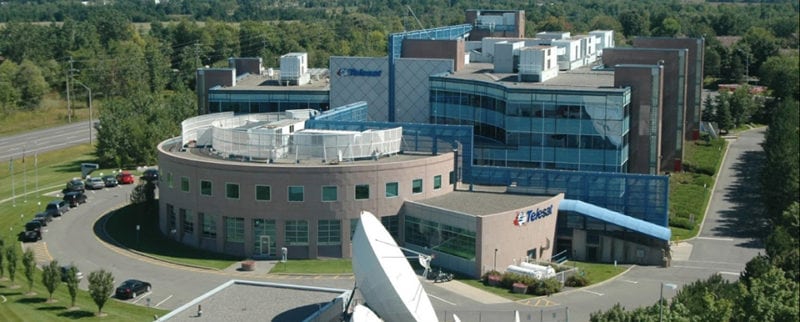Telesat to Merge With Loral Space to Form Public Company

Telesat headquarters. Photo: Telesat.
Telesat Canada is combining with major shareholder Loral Space & Communications to form one public company to finance its Low-Earth Orbit (LEO) constellation.
Telesat Canada and its co-owners Loral Space and Canada’s Public Sector Pension Investment Board (PSP Investments) revealed Tuesday that Telesat Canada and Loral will become subsidiaries of Telesat Corporation, a new publicly traded Canadian incorporated and controlled company. The company will be headquartered in Ottawa and led by Telesat CEO Dan Goldberg.
“Following the closing of the transaction, Telesat will have access to the public equity markets, providing increased flexibility and optionality to support our promising investment opportunities, including Telesat LEO, which will bridge the digital divide both at home in Canada and around the world, and give our customers the competitive advantage they need to be successful,” Goldberg commented in the news release.
Under the deal, when the transaction closes, Loral stockholders — together with PSP Investments and certain current and former management shareholders of Telesat — will beneficially own all of the equity in the new Telesat in approximately the same proportion as their current, indirect ownership in Telesat. Loral stockholders not affiliated with the funds managed by MHR Fund Management LLC will beneficially own 26.1% of the economic interests in Telesat, with the MHR Funds, PSP Investments and management shareholders of Telesat beneficially owning the remaining 36.6%, 36.7%, and 0.7%, respectively, of the economic interests in the new Telesat.
The transaction is subject to approvals and is expected to close in the second or third quarter of 2021. The shares of Telesat will be listed on the Nasdaq Global Select Market, and Telesat is also considering a listing on a Canadian stock exchange.
In a Tuesday call with Loral investors, Loral Vice Chairman Michael Targoff said the length of time until anticipated closing is due to the various regulatory approvals required.
“We believe [the transaction] should bring numerous benefits to our stockholders. These include, among others, Telesat’s desire to access the public equity markets to obtain financing for it’s important LEO constellation, positioning Telesat without the restraints of the complex current ownership structure, for future growth, in whatever form that will take,” Targoff said of the transaction.
This agreement has been long anticipated. In April, Loral said it was in advanced discussions with PSP Investments about the combination.
“Fortunately, the timing is such that it doesn’t impede in any way Telesat’s plans. It should be consistent with the requirements Telesat may have for raising equity to support its LEO project,” Targoff said on finally reaching the deal.
During Telesat’s Q3 earnings call last month, Goldberg discussed the option of financing Telesat LEO through an IPO. He expects Telesat LEO to require billions of dollars of CapEx, which he expects to be financed through one third equity, two-thirds debt. “If Telesat were to go public, and if Telesat were to issue equity as part of that process, certainly the proceeds of an offering could be used to invest in LEO,” Goldberg said at the time.
Telesat has not yet announced manufacturing and launch vendors for Telesat LEO, but Goldberg said in Q3 the company is in “very advanced” discussions and he expects to make some announcements by the end of the year.
Telesat LEO, a planned network of 298 satellites, will offer capacity for broadband internet. Telesat is targeting the project to serve backhaul needs for Mobile Network Operators (MNOs), telcos ,and Internet Service Providers (ISPs), along with aero, maritime, and government services.
Earlier this month, Telesat reached a $462 million (600 million Canadian dollars) agreement with the Canadian government to offer a dedicated pool of capacity that MNOs and ISPs can purchase at reduced rates to serve eligible rural households and Indigenous communities in Canada.